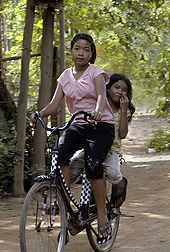- Childhood and adolescence in Cambodia
-
Contents
Early Childhood
A Cambodian child may be nursed until he or she is between two and four years of age. Up to the age of three or four, the child is given considerable physical affection and freedom. There is little corporal punishment. After reaching the age of about four, children are expected to feed and bathe themselves and to control their bowel functions. Children around five years of age also may be expected to help look after younger siblings. Children's games emphasize socialization or skill rather than winning and losing.[1]
Pre-Adolescence
Most children begin school when they are seven or eight. By the time they reach this age, they are familiar with the society's norms of politeness, obedience, and respect toward their elders and toward Buddhist monks. The father at this time begins his permanent retreat into a relatively remote, authoritarian role. By age ten, a girl is expected to help her mother in basic household tasks; a boy knows how to care for the family's livestock and can do farm work under the supervision of older males.[1]
In precommunist days, parents exerted complete authority over their children until the children were married, and the parents continued to maintain some control well into the marriage. Punishment was meted out sparingly, but it might have involved physical contact. Age difference was strictly recognized. The proper polite vocabulary was used in the precommunist period, and special generational terms for "you" continued to be used in the late 1980s. Younger speakers had to show respect to older people, including siblings, even if their ages differed by only a few minutes.[1]
Teen years
Between the ages of seven and nineteen, but most commonly after the eleventh birthday, a boy may become a Theravada temple servant and go on to serve a time as a novice monk. Having a son chosen for such a position is a great honor for the parents, and earns the individual son much merit.[1]
Formerly, and still in some rural areas, a ceremony marked the entrance of a girl into puberty. Upon the onset of menstruation, a girl would participate in a ritual called chol mlup (entering the shadow). Certain foods were taboo at this time, and she would be isolated from her family for a period of a few days to six months. After the period of seclusion, she was considered marriageable.[1]
Adolescent children usually play with members of the same sex. The main exception to this occurs during festivals, especially the New Year Festival, when boys and girls take part in group games.[1]
References
- ^ a b c d e f Federal Research Division. Russell R. Ross, ed. "Families". Cambodia: A Country Study. Research completed December 1987. This article incorporates text from this source, which is in the public domain.
Categories:- Adolescence
- Childhood
- Cambodian culture
- Cambodian society
Wikimedia Foundation. 2010.

